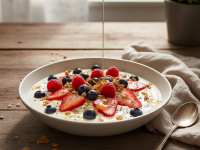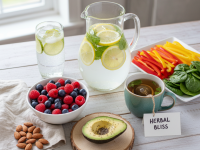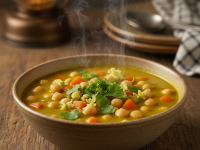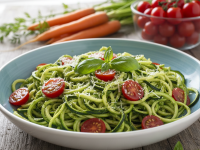You know that feeling, right? You’ve just enjoyed a delicious banana, peeled it, and without a second thought, the peel goes straight into the bin. It’s a common ritual, a little bit of kitchen waste we barely register. But what if I told you that those seemingly useless banana peels are actually packed with incredible nutrients, and with a little bit of magic — the magic of fermentation — you can transform them into a delicious, gut-healing superfood drink? Well, let me tell you, because I’ve done it, and my kitchen (and my gut!) has never been the same.
My journey into fermenting banana peels started out of pure curiosity and a growing desire to minimize food waste. I’d been dabbling in making my own kombucha and sourdough for a while, fascinated by the transformative power of microbes. Then, I stumbled upon an old farming trick: using banana peels to enrich soil. This got me thinking — if they’re good for plants, what about us? A quick dive into research revealed that banana peels are far from waste; they’re nutritional powerhouses! That’s when the “aha!” moment hit: what if I could ferment them?
What followed was a series of experiments, a few questionable batches (that’s part of the fun, right?), and finally, a recipe that consistently delivers a tangy, slightly sweet, and utterly refreshing drink. It’s become a staple in my home, not just for its unique taste, but for the incredible benefits I’ve personally experienced. So, ditch the guilt of tossing those peels, and let me walk you through how you can turn your kitchen waste into a truly remarkable beverage.
Why Banana Peels? More Than Just Fruit Wrappers!
Before we dive into the fermentation fun, let’s talk about why we should even bother with banana peels. Like many people, I used to think the good stuff was all in the fruit. Boy, was I wrong! It turns out, banana peels are incredibly nutrient-dense. They contain:
- Fiber: Crucial for digestive health, helping to keep things moving smoothly.
- Antioxidants: Such as polyphenols and carotenoids, which fight off free radicals and reduce inflammation.
- Vitamins: Particularly Vitamin B6 and B12, along with some Vitamin C.
- Minerals: Magnesium and potassium, essential for various bodily functions.
In fact, some studies suggest that the peels contain higher concentrations of certaiutrients than the fruit itself! My personal discovery of this fact was a game-changer. It felt like I had been throwing away a hidden treasure all these years. Beyond the nutritional punch, using the peels aligns perfectly with a zero-waste lifestyle, making it a win-win for both your body and the planet.
The Fermentation Factor: Why Bother Fermenting?
You might be thinking, “Okay, so peels are healthy, but why ferment them?” This is where the real magic happens, my friend. Fermentation isn’t just a way to preserve food; it’s a process that transforms it, making nutrients more accessible and creating new beneficial compounds. Here’s why I’m convinced fermentation is the key:
- Probiotics Galore: Just like kombucha or sauerkraut, fermented banana peel drink becomes a rich source of beneficial bacteria. These probiotics are champions for your gut microbiome, aiding digestion, boosting immunity, and even influencing mood. I’ve noticed a significant improvement in my own digestive comfort since incorporating fermented foods regularly.
- Enhanced Nutrient Bioavailability: Fermentation can break down complex compounds in the peels, making their vitamins and minerals easier for your body to absorb. Think of it as pre-digestion!
- Unique Flavor Profile: The fermentation process introduces a lovely tang and effervescence, transforming the subtle banana flavor into something much more complex and refreshing. It’s genuinely delicious!
- Reduced Waste: This is a big one for me. Instead of discarding the peels, you’re giving them a new, valuable life. It’s incredibly satisfying to know you’re making the most out of every part of your food.
My journey with fermentation has taught me that these tiny microbes are powerful allies. They turn simple ingredients into something truly extraordinary, and this banana peel elixir is a shining example.
My First Dive: What You’ll Need (It’s Simpler Than You Think!)
When I first started, I assumed I’d need specialized equipment, but I quickly learned that simplicity is key. You likely have most of these items in your kitchen already!
Ingredients:
- Banana Peels: From 3-4 ripe, organic bananas. Organic is preferred to avoid pesticides, as you’re using the outer layer. Make sure they are clean — a quick rinse is good.
- Filtered Water: About 4 cups (1 liter). Chlorine in tap water can inhibit fermentation, so filtered or distilled is best.
- Sugar: 1/4 cup. White sugar works fine. The microbes eat this, so very little remains in the final product. Don’t worry, it’s not for sweetness (though it does contribute a tiny bit!).
- Starter Culture (Optional but Recommended): A tablespoon or two of kombucha, kefir, or even a bit of brine from unpasteurized sauerkraut can kickstart the process and ensure a healthy fermentation. I usually use a splash of my homemade kombucha. If you don’t have one, you can rely on wild fermentation, but it might take a bit longer and be less predictable.
- Optional Flavorings: A slice of fresh ginger, a ciamon stick, a few cloves, or a squeeze of lemon juice — these can add wonderful layers of flavor after the initial fermentation. I love adding ginger!
Equipment:
- Large Glass Jar: A clean, wide-mouth jar (at least 1-liter capacity) is perfect.
- Cheesecloth or Breathable Fabric: To cover the jar.
- Rubber Band: To secure the cloth.
- Strainer and Bottle: For bottling the finished drink.
That’s it! No fancy gadgets required. My initial setup was literally just an old pasta sauce jar, some spare fabric, and a rubber band. It proved that you don’t need to spend a fortune to start your fermentation journey.
The Recipe: My Go-To Fermented Banana Peel Elixir
Here’s my tried-and-true method for making this incredible drink. Remember, fermentation is a living process, so don’t be afraid to experiment a little once you get the hang of it!
- Prepare Your Peels: Thoroughly wash your banana peels. I usually give them a good scrub under ruing water. Cut them into smaller pieces, about 1-2 inches long. This increases their surface area, making fermentation more efficient.
- Combine Ingredients in Jar: Place the cut banana peels into your clean glass jar. Add the 1/4 cup of sugar and your optional starter culture (if using). If you’re using flavorings like ginger or ciamon, add them now.
- Add Water: Pour the filtered water into the jar, making sure the banana peels are fully submerged. You might need to gently press them down. Leave about an inch or two of headspace at the top of the jar.
- Cover and Secure: Cover the mouth of the jar with the cheesecloth or breathable fabric and secure it tightly with a rubber band. This allows air to circulate while keeping unwanted pests out.
- Ferment: Place your jar in a warm spot, out of direct sunlight. An ideal temperature is around 68-78°F (20-25°C). Let it ferment for 3-7 days.
The Waiting Game: What to Expect During Fermentation
This is where patience and observation come into play. Here’s what I’ve learned to look for:
- Day 1-2: Not much might happen visibly, especially if you’re not using a starter culture. But don’t worry, the microbes are getting acquainted!
- Day 3-5: You should start to see small bubbles forming and rising to the surface. This is a sign that the fermentation is active, and the microbes are busy converting the sugars. You might also notice a slightly yeasty or tangy smell developing — this is good!
- Taste Testing: After about 3 days, I recommend doing a taste test daily. Use a clean spoon to scoop out a tiny bit of liquid. It should taste slightly sweet and tangy, gradually becoming more acidic over time. When it reaches a flavor you enjoy, it’s ready! My sweet spot is usually around 4-5 days.
Troubleshooting (Based on My Own Learning Curve!):
- Mold vs. Kahm Yeast: Sometimes, a white, wrinkly film can form on the surface. This is usually kahm yeast, which is harmless and can be skimmed off. However, if you see fuzzy, colorful patches (green, black, pink), that’s mold, and you’ll need to discard the batch and start over. Always trust your nose — if it smells bad, it probably is.
- No Bubbles: If you’re not seeing activity after a few days, try moving the jar to a slightly warmer spot or adding a bit more starter culture. Sometimes, the ambient temperature isn’t quite right.
Drinking My Superfood: Taste, Texture, and How I Enjoy It
Once your fermented banana peel drink is ready, it’s time to enjoy the fruits (or peels!) of your labor!
- Strain: Strain the liquid into a clean bottle, discarding the banana peels and any added flavorings.
- Bottle and Refrigerate: Seal the bottle and refrigerate. This slows down the fermentation process significantly.
The taste is unique — it’s lightly carbonated (depending on how long you let it ferment and if you bottle for a second ferment), tangy, with a subtle hint of banana that’s much more nuanced than the fresh fruit. It’s incredibly refreshing, especially chilled.
I typically enjoy a small glass (about 4-6 oz) first thing in the morning or as an afternoon pick-me-up. It’s also fantastic mixed with a splash of sparkling water or even added to smoothies for an extra probiotic boost. My favorite way is just plain, cold, perhaps with a squeeze of fresh lime — so simple, yet so satisfying.
Beyond the Drink: Other Uses for Fermented Banana Peels (Bonus!)
While this article focuses on the drink, my passion for sustainability means I rarely stop at just one use. The leftover fermented banana peels, once strained, can still be valuable!
- Compost Booster: Add them to your compost pile. The fermentation process has already started breaking them down, making them even better for your soil.
- Plant Fertilizer: You can blend the spent peels with water and use the slurry as a nutrient-rich fertilizer for your houseplants or garden. My tomatoes absolutely love it!
It’s truly a testament to the fact that what we often consider “waste” is anything but.
Conclusion
Making your own fermented banana peel drink isn’t just a recipe; it’s an adventure in sustainable living, a dive into the wonders of microbiology, and a delicious way to boost your health. From the initial skepticism to the satisfying fizz of my first perfect batch, this journey has been incredibly rewarding. I’ve learned that hidden gems often lie in the most unexpected places — even in a banana peel.
So, the next time you peel a banana, pause for a moment. Instead of tossing that peel, consider giving it a new life. You’ll be amazed at what you can create. Not only will you be contributing to a more sustainable planet, but you’ll also be nourishing your body with a homemade superfood that’s packed with goodness. Give it a try — your gut will thank you!




